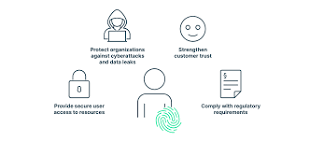The Benefits of Cloud Identity Manager
In today’s digital age, managing user identities and access rights across various applications and services can be a complex and challenging task for organisations. This is where a Cloud Identity Manager comes into play, offering a range of benefits that streamline identity management processes and enhance security.
Centralised Identity Management
One of the key advantages of a Cloud Identity Manager is centralised identity management. With this solution, organisations can maintain a single source of truth for user identities, ensuring consistency and accuracy across all systems and applications. This centralisation simplifies user provisioning, deprovisioning, and access control, reducing the risk of errors and security vulnerabilities.
Enhanced Security
Cloud Identity Managers offer robust security features that help protect sensitive data and prevent unauthorised access. Multi-factor authentication, role-based access control, and automated policy enforcement are some of the security measures that can be implemented to strengthen identity management practices in the cloud environment. By enforcing strict security protocols, organisations can mitigate the risk of data breaches and compliance violations.
Improved User Experience
By implementing a Cloud Identity Manager, organisations can enhance the user experience for employees, customers, and partners. Single sign-on capabilities enable users to access multiple applications with a single set of credentials, eliminating the need to remember numerous passwords. This convenience not only boosts productivity but also reduces the likelihood of password-related issues.
Scalability and Flexibility
Cloud-based identity management solutions offer scalability and flexibility to accommodate changing business needs. Organisations can easily scale their identity infrastructure up or down based on demand without significant upfront investments in hardware or software. Additionally, cloud identity managers support integration with various third-party applications and services, allowing organisations to adapt to evolving technology landscapes seamlessly.
Cost-Efficiency
Implementing a Cloud Identity Manager can result in cost savings for organisations by eliminating the need for on-premises infrastructure maintenance and reducing administrative overheads associated with manual identity management processes. With pay-as-you-go pricing models offered by many cloud service providers, organisations can optimise their identity management costs based on actual usage requirements.
In conclusion, a Cloud Identity Manager offers numerous benefits that empower organisations to efficiently manage user identities while enhancing security posture in today’s dynamic digital landscape. By leveraging centralised identity management capabilities, robust security features, improved user experience, scalability, flexibility, and cost-efficiency provided by cloud-based solutions, organisations can effectively address the complexities of modern identity management challenges.
7 Essential Tips for Secure Cloud Identity Management
- Ensure strong password policies are in place.
- Implement multi-factor authentication for added security.
- Regularly review and update user access permissions.
- Encrypt sensitive data stored in the cloud.
- Monitor and audit user activity to detect any suspicious behaviour.
- Integrate with existing identity management systems for seamless user experience.
- Provide training to users on best practices for secure cloud identity management.
Ensure strong password policies are in place.
To enhance security within a Cloud Identity Manager, it is crucial to ensure that strong password policies are in place. By enforcing robust password requirements such as minimum length, complexity criteria, and regular password changes, organisations can significantly reduce the risk of unauthorised access and data breaches. Strong password policies act as a fundamental layer of defence in safeguarding user accounts and sensitive information stored in the cloud environment, ultimately contributing to a more secure identity management infrastructure.
Implement multi-factor authentication for added security.
Implementing multi-factor authentication (MFA) is a crucial tip when utilising a Cloud Identity Manager to enhance security measures. By requiring users to provide multiple forms of verification, such as passwords, biometrics, or security tokens, before granting access to applications and data, organisations can significantly reduce the risk of unauthorised access and data breaches. MFA adds an extra layer of protection beyond traditional password-based authentication, making it more challenging for malicious actors to compromise user accounts. This proactive approach not only strengthens security but also instils confidence in users that their identities and sensitive information are well-protected in the cloud environment.
Regularly review and update user access permissions.
In the realm of cloud identity management, a crucial tip is to regularly review and update user access permissions. By conducting periodic reviews of user access rights and permissions within the cloud environment, organisations can ensure that users have the appropriate level of access based on their roles and responsibilities. This proactive approach helps mitigate the risk of unauthorised access to sensitive data and resources, enhancing overall security posture. Regularly updating user access permissions also promotes compliance with regulations and internal security policies, contributing to a robust and well-managed identity management framework.
Encrypt sensitive data stored in the cloud.
To enhance security when using a Cloud Identity Manager, it is crucial to encrypt sensitive data stored in the cloud. By encrypting data at rest and in transit, organisations can safeguard confidential information from unauthorised access or breaches. Encryption adds an extra layer of protection, ensuring that even if data is compromised, it remains unreadable and unusable to malicious actors. Implementing robust encryption practices is essential for maintaining the integrity and confidentiality of sensitive data within the cloud environment.
Monitor and audit user activity to detect any suspicious behaviour.
Monitoring and auditing user activity is a crucial tip when utilising a Cloud Identity Manager. By actively monitoring user interactions and auditing their activities, organisations can promptly detect any suspicious behaviour or unauthorised access attempts within their cloud environment. This proactive approach not only enhances security but also allows for swift responses to potential threats, ultimately safeguarding sensitive data and maintaining the integrity of the identity management system.
Integrate with existing identity management systems for seamless user experience.
To enhance the user experience and streamline identity management processes, it is advisable to integrate a Cloud Identity Manager with existing identity management systems. By seamlessly connecting these systems, organisations can ensure a cohesive user experience across different applications and services. This integration allows for efficient user authentication, access control, and provisioning while maintaining consistency in user identities. Ultimately, integrating with existing identity management systems enables organisations to leverage the full potential of their cloud identity manager and optimise user interactions within the digital environment.
Provide training to users on best practices for secure cloud identity management.
To maximise the effectiveness of a Cloud Identity Manager, it is essential to provide comprehensive training to users on best practices for secure cloud identity management. Educating users on how to create strong passwords, enable multi-factor authentication, and recognise phishing attempts can significantly enhance the overall security posture of an organisation’s cloud environment. By empowering users with the knowledge and skills to protect their identities and data in the cloud, organisations can minimise the risk of security breaches and ensure a more secure and resilient digital infrastructure.




